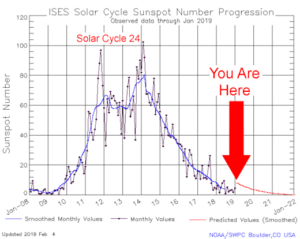by Shaviv, December 19, 2017 in ScieneBits/fromNature
Archives par mot-clé : Cosmic Rays
Un mécanisme russe pour expliquer le réchauffement global
par Jean N., 4 mai 2019 in Science-Climat-Energie
Dans une récente publication[1] de 2019, l’équipe russe de G.A. Zherebtsov présente un mécanisme permettant d’expliquer le réchauffement global. Ce mécanisme, basé sur une série d’observations, ne fait pas intervenir le taux de CO2 atmosphérique mais les rayons cosmiques solaires ainsi que le champ électromagnétique terrestre. Les chercheurs qui ont pensé à ce mécanisme (inconnu du GIEC) font tous partie de l’institut de Physique Terrestre et Solaire de la Branche Sibérienne de l’Académie Russe des Sciences (Irkutsk, Russie). Si le mécanisme de l’équipe de Zherebtsov est correct, on pourrait alors se passer de l’hypothèse de l’effet de serre radiatif qui, comme vous le savez peut-être, pose certains problèmes (voir ici, ici et ici). Le but du présent article est simplement de présenter ce mécanisme et de montrer par la même occasion que la science du climat est loin d’être dite.
1. Observations réalisées le 7 novembre 2004
Les chercheurs russes ont d’abord constaté qu’à certaines latitudes il y a un lien assez fort entre le flux de rayons cosmiques solaires (RCS) et la température de la troposphère. Ceci est par exemple bien visible dans un évènement qui a débuté le 7 novembre 2004 au niveau des hautes latitudes de l’hémisphère nord (55°N-65°N). Ce jour-là, le flux de RCS était particulièrement fort d’environ 3 ordres de grandeur plus élevé par rapport à la normale (Figure 1a). Une tempête géomagnétique s’est ensuite déclarée le jour suivant et a duré au moins 5 jours (il s’agit de fluctuations brusques et intenses du magnétisme terrestre qui proviennent d’une perturbation de l’ionosphère par l’activité solaire). Ceci est bien visible sur le tracé des indices géomagnétiques AE (Figure 1b) et Dst (voir aussi ici), indices obtenus par certaines stations de mesure placées au sol et réparties en divers endroits de la planète (Figure 1c). Il existe de nombreux indices géomagnétiques et il n’est pas nécessaire d’être un spécialiste pour comprendre la suite du présent article. Il faut simplement retenir que le champ magnétique terrestre est perturbé les jours suivant l’arrivée des RCS. Voyons maintenant si tout ceci peut avoir un effet sur la température de la basse troposphère.
…

Figure 4. Diagramme présentant le mécanisme de Zherebtsov. Source : Zherebtsov et al. (2019) J Atm Solar Terrestrial Physics 182:217–222 (traduit de l’anglais).
A Month Without Sunspots
by Dr Tony Phillips, March 6, 2019 in SpaceWeatherArchive
March 1, 2019: There are 28 days in February. This year, all 28 of them were spotless. The sun had no sunspots for the entire month of Feb. 2019. This is how the solar disk looked every day:
…
How does this affect us on Earth? The biggest change may be cosmic rays. High energy particles from deep space penetrate the inner solar system with greater ease during periods of low solar activity. Indeed, NASA spacecraft and space weather balloons are detecting just such an increase in radiation. Cosmic rays can alter the flow of electricity through Earth’s atmosphere, trigger lightning, potentially alter cloud cover, and dose commercial air travelers with extra “rads on a plane.”
As February ended, March is beginning … with no sunspots. Welcome to Solar Minimum!
Munich Conference: Leading Danish Astrophysicist Says Solar Activity Has Significant Impact On Global Climate
by Prof. H. Svensmark, January 22, 2019 in NoTricksZone
Danish Professor Henrik Svensmark is a leading physicist of cosmic radiation. At the end of last year he made a presentation at the 12th International Climate Conference in Munich, where he demonstrated that the climate is indeed modulated in large part by cloud cover, which in turn is modulated by solar activity in combination with cosmic rays.
His theory is that cosmic rays, which are extremely fast-flying particles – which originate from dying supernovae – travel through the cosmos, strike the Earth’s atmosphere and have a major impact on cloud cover and thus climate on the Earth’s surface.
This, Svensmark says, has been confirmed in numerous laboratory experiments.
…


